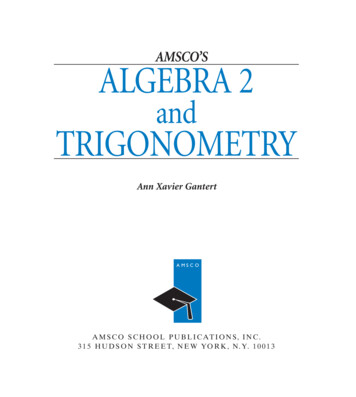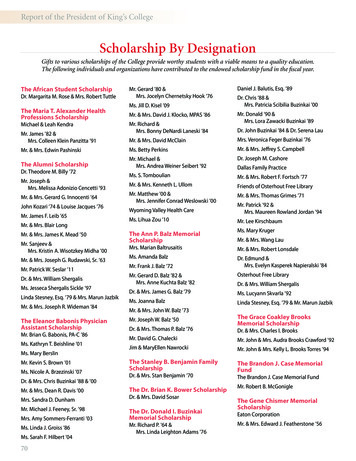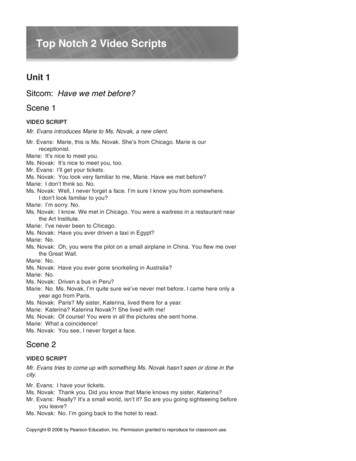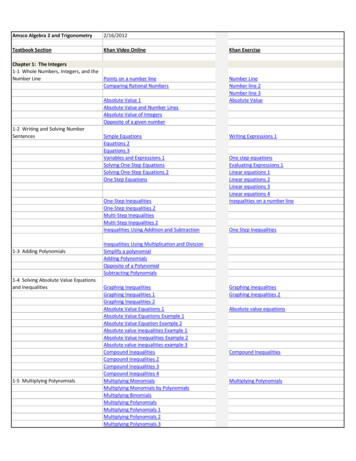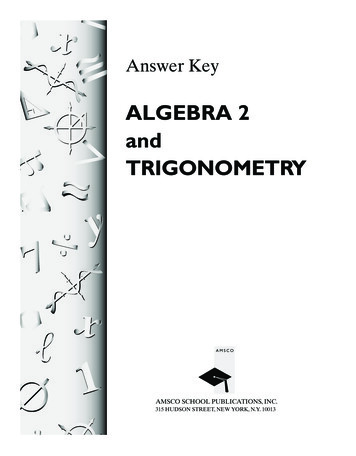
Transcription
14580AK FM.pgs11/26/0810:49 AMPage iAnswer KeyALGEBRA 2andTRIGONOMETRYAMSCOAMSCO SCHOOL PUBLICATIONS, INC.315 HUDSON STREET, NEW YORK, N.Y. 10013
14580AK FM.pgs11/26/0810:49 AMPage iiPlease visit our Web site at: www.amscopub.comWhen ordering this book, please specify: N 159 K orANSWER KEY/ALGEBRA 2 AND TRIGONOMETRYCopyright 2009 by Amsco School Publications, Inc.No part of this Answer Key may be reproduced in any form without written permission from thepublisher except by those teachers using the AMSCO textbook ALGEBRA 2 ANDTRIGONOMETRY, who may reproduce or adapt portions of this key in limited quantities forclassroom use only.Printed in the United States of America1 2 3 4 5 6 7 8 9 1014 13 12 11 10 09
14580AK FM.pgs11/26/0810:49 AMPage iiiContentsChapter 12345678910111213141516The Integers1The Rational Numbers4Real Numbers and Radicals7Relations and Functions12Quadratic Functions and Complex Numbers21Sequences and Series29Exponential Functions33Logarithmic Functions38Trigonometric Functions42More Trigonometric Functions49Graphs of Trigonometric Functions54Trigonometric Identities64Trigonometric Equations73Trigonometric Applications75Statistics79Probability and the Binomial Theorem89lsleiii
14580AK01.pgs11/26/0810:06 AMPage 1Answers for Textbook ExercisesChapter 1.The Integers1-1 Whole Numbers, Integers, and theNumber Line (page 4)20.21.22.23.Writing About Mathematics1. Answers will vary. Example: Have Tina count tothree on her fingers, then count to two on herremaining fingers. Show her that if she counts thetotal number of fingers it equals five.2. Yes. Both sides of the equation refer to the samedistance along the number line.Developing Skills3. 64. 125. 56. 57. 78. 79. 410. 011. 012. 413. 2514. 215. 8 1 (25) 5 316. 7 1 (2(22)) 5 917. 22 1 (25) 5 2718. 28 1 (2(25)) 5 2319. {21, 11}Applying Skills20. 2 2021. a. 2 75b. 2 2322. 1 10012n 1 8 5 80, six nights5 1 3h 5 44, 13 hours19 1 5d , 49, five plants5d 1 4 # 14, two hours1-3 Adding Polynomials (pages 12–13)Writing About Mathematics1. Yes. If x is negative, 2x 1 1 will always begreater than x. If x is positive (or zero), 2x 1 1 isalways greater than x.2. No. Terms in each polynomial may or may nothave like terms in the other polynomial.Furthermore, if like terms have coefficients withequal value but opposite signs, adding them willeliminate a term with that power. Thus, the sumof a trinomial and a binomial may have anywherefrom zero to five terms.Developing Skills3. 5y 2 134. 5x2 1 x 1 125. 7x 2 5x 2 46. 3x7. 2a2b2 1 28. 4b2 2 10b9. 26 2 3b10. x2 1 7x 2 8211. 4y 2 3y 2 412. 2a4 1 a3 2 5a2 1 a 2 113. 614. 415. 2516. 2317. x , 12, { . . . , 9, 10, 11}18. y 2, {2, 3, 4, . . . }19. y # 21, { . . . , 23, 22, 21}20. c . 4, {5, 6, 7, . . . }21. 122. x # 25, { . . . , 27, 26, 25}Applying Skills23. 2.0024. a. 6x 1 10b. 4 feet wide and 13 feet long25. 50 cents1-2 Writing and Solving NumberSentences (pages 8–9)Writing About Mathematics1. Taking an absolute value always yields a positivenumber. There is no positive number that can besubtracted from 12 to yield 15.2. No. Dividing both sides of an inequality by anegative number reverses the direction of theinequality.Developing Skills3. 74. 35. 226. 227. 48. 229. {9, 213}10. {25, 11}11. {21, 7}12. {10, 213}13. a . 2, {3, 4, 5, . . . }14. b 4, {4, 5, 6, . . . }15. 1 , x , 3, {2}16. 3 , x , 7, {4, 5, 6}17. 21 b 2, {21, 0, 1, 2}Applying Skills18. 156 2 3g # 9, 49 cents19. 5g 1 3 5 18, three groups1-4 Solving Absolute Value Equations andInequalities (pages 16–17)Writing About Mathematics1. The absolute value of a number is equal to theabsolute value of its negative.1
14580AK01.pgs11/26/0810:06 AMPage 22. Subtract 7 from both sides. The absolute value isthen equal to a negative number, which makesthe solution set empty.Developing Skills3. {27, 17}4. {22, 214}5. {21, 6}6. {23, 7}7. {1, 7}8. {3, 24}9. {5, 9}10. {3, 23}11. {2, 210}12. {23, 8}13. 14. {23, 17}15. x , 29 or x . 9,{. . . , 212, 211, 210, 10, 11, 12, . . .}16. x , 29 or x . 5, {. . . , 212, 211, 210, 6, 7, 8, . . .}17. 211 # b # 21, {211, 210, 29, . . . , 23, 22, 21}18. 21 , y , 7, {0, 1, 2, 3, 4, 5, 6}19. y , 219 or y . 7,{. . . , 222, 221, 220, 8, 9, 10, . . .}20. b # 21 or b 8, {. . . , 23, 22, 21, 8, 9, 10, . . .}21. 23 , x , 7, {22, 21, 0, 1, 2, 3, 4, 5, 6}22. The set of integers23. 0 , b , 10, {1, 2, 3, 4, 5, 6, 7, 8, 9}24. b , 23 or b . 14, {. . . , 26, 25, 24, 15, 16, 17, . . .}25. 26. 23 # b # 17, {23, 22, 21, . . . , 15, 16, 17}27. {253, 254, 255, 256, 257, 258, 259}, 253 # x # 25928. {150, 151, 152, 153, . . . , 297, 298, 299, 300},150 # t # 30029. c 2 200 # 28, solution 5 172 # c # 228,{172, 173, 174, . . . , 226, 227, 228}31. a. a 5 c 2 1, b 5 c 2 8b. a2 1 b2 5 (c 2 1) 2 1 (c 2 8) 25 2c2 2 18c 1 65c. 2c2 2 18c 1 651-6 Factoring Polynomials (pages 26–27)Writing About Mathematics1. Yes. If we multiply these factors back together,we get x2 1 (d 1 e)x 1 de.2. No. These factors will yield 4 as the last terminstead of 24.Developing Skills3. 4x(2x 1 3)4. 3a2(2a2 2 a 1 3)5. 5ab(b 2 3 1 4a)6. x2y2(xy 2 2x 1 1)7. 4a(1 2 3b 1 4a)8. 7(3a2 2 2a 1 1)9. (y 2 1)(y 1 1)10. (3b 2 4)(b 2 2)11. (2x 1 3)(y 1 4)12. (a2 1 3)(a 2 3)213. (x 2 2)(2x 2 3)14. (y2 2 5)(y 1 1)15. (x 1 7)(x 1 1)16. (x 1 3)(x 1 2)17. (x 2 3)(x 2 2)18. (x 1 6)(x 2 1)19. (x 2 3)(x 1 2)20. (x 1 4)(x 1 5)21. (3x 1 4)(x 2 3)22. (2y 2 1)(y 1 3)23. (5b 1 1)(b 1 1)24. (6x 2 1)(x 2 2)25. (2y 1 1)(2y 1 1)26. (3x 2 2)(3x 2 2)27. (a 1 3)(a 1 1)(a 2 1)28. 5(x 2 1)(x 2 2)29. b(b 1 2)(b 2 2)30. 4a(x 1 3)(x 2 2)31. 3(2c 1 1)(2c 2 1)32. (x2 1 9)(x 1 3)(x 2 3)33. (x2 1 4)(x 1 2)(x 2 2)34. x(2x 1 3)(x 1 5)35. 2x(2x 2 3)(x 2 1)36. (z2 2 3)(z 1 3)(z 2 3)37. (c 1 3)(c 1 1)38. (y 1 1)(2y 1 3) 5 21(y 2 3)(y 1 1)39. y(x 1 4)(x 2 4)40. 3(x 2 3)(x 1 1)41. 29(x 1 1)(x 1 3)Applying Skills42. (4x 1 1)(x 2 2)43. (4x 1 5)(4x 2 5)44. (3x 2 1)(3x 2 1)45. (3x 2 1)(x 1 2)1-5 Multiplying Polynomials (page 21)Writing About Mathematics1. No. Using FOIL, the answer is(a 1 3)(a 1 3) 5 a2 1 6a 1 9.2. Six. Each term of the trinomial (3) is multipliedby each term of the binomial (2).Developing Skills3. 14a8b44. 212c3d42 45. 36x y6. 9c887. 29c8. 15b2 2 12b2 22 39. 2x y 2 4x y10. 2x2 1 5x 2 3211. a 2 a 2 2012. 3x2 2 5x 2 213. a2 2 914. 25b2 2 415. a2 1 6a 1 916. 9b2 2 12b 1 43217. y 2 3y 1 3y 2 118. 2x3 1 5x2 2 7x 2 1519. 11a 2 1220. 4b2 1 5b221. 8y 2 7y 2 1022. 023. z3 2 6z2 1 12z 2 824. 2525. 326. 227. 128. 629. 4Applying Skills30. 2x2 1 4x1-7 Quadratic Equations with IntegralRoots (pages 29–30)Writing About Mathematics1. No. If the product of two expressions is zero, atleast one of the two expressions must be zero.This is not true for other numbers.2
14580AK01.pgs11/26/0810:06 AMPage 32. Yes. If the product of any number of expressionsis zero, at least one of the expressions must bezero.Developing Skills3. {1, 3}4.6. {21, 25}7.9. {21, 4}10.12. {23, 4}13.15. {23, 2}16.19. {1 ft by 3 ft by 3 ft, 2 ft by 4 ft by 3 ft, 3 ft by 5 ftby 3 ft, 4 ft by 6 ft by 3 ft}Review Exercises (pages 37–38){2, 5}{2, 212}{3, 210}{1, 36.37.38.39.40.41.{21, 6}{21, 10}{22, 3}{3}{5}Applying Skills18. Francis is 11, Brad is 14.19. Length: 30 ft, width: 18 ft20. Width: 8 ft, length: 18 ft21. 9 cm, 12 cm, 15 cm22. 3 seconds1-8 Quadratic Inequalities (page 35)Writing About Mathematics1. No. If all three factors are negative, the productwill be negative. Furthermore, if two factors arenegative, the product will be positive.2. a. Yes. The solution set is 5 , x , 7; thus, anyvalue makes (x 2 7) the negative factor and(x 2 5) the positive factor.b. No. We can tell for binomial factors of theform (x 1 a)(x 1 b) where a and b are given.However, in other products, such as xy, eitherfactor can be the positive factor.Developing Skills3. 23 , x , 22, [4. x , 26 or x . 1, {. . . , 29, 28, 27, 2, 3, 4, . . .}5. 1 # x # 2, {1, 2}6. x , 2 or x . 5, {. . . , 21, 0, 1, 6, 7, 8, . . .}7. 22 , x , 3, {21, 0, 1, 2}8. x # 22 or x 10,{. . . , 24, 23, 22, 10, 11, 12, . . .}9. 24 , x , 3, {23, 22, 21, 0, 1, 2}10. x , 1 or x . 5, {. . . , 22, 21, 0, 6, 7, 8, . . .}11. x # 0 or x 2, {. . . , 22, 21, 0, 2, 3, 4, . . .}12. 22 , x , 3, {21, 0, 1, 2}13. x , 2 or x . 2, {. . . , 21, 0, 1, 3, 4, 5, . . .}14. The set of integers15. 22 , x , 1, {21, 0}16. 23 # x # 4, {23, 22, 21, 0, 1, 2, 3, 4}17. x , 23 or x . 4, {. . . , 26, 25, 24, 5, 6, 7, . . .}42.43.44.45.22x2. 2a 1 1223d 1 74. 3b2 2 25b 1 4526. 22a2 2 2ax 1 7x 2 202214d 1 19cd 2 3c8. x2 2 x 2 1410. 02x212. y2 2 4y2(x 1 1)(x 1 3)3(a 2 5)(a 2 5) or 3(a 2 5) 25x(x 1 1)(x 2 4)10a(b 1 2)(b 2 2)(c2 1 4)(c 1 2)(c 2 2)3(y2 1 2)(y 2 4)(x 2 1)(x 1 1)(x 1 5)(x 1 1)(x 2 1)(x 1 1)(x 2 1)2(x 2 3)(x 2 6)x(x 2 2)(x 2 1)5(a2 1 b2)(a 1 b)(a 2 b)(5x 2 3)(x 1 5)2913x . 4, {5, 6, 7, . . . }21 # x , 4, {21, 0, 1, 2, 3}{2, 27}{6, 28}y , 21 or y . 2, {. . . , 24, 23, 22, 3, 4, 5, . . .}x , 25 or x . 21, {. . . , 28, 27, 26, 0, 1, 2, . . .}{4, 5}{5, 7}26 , x , 21, {25, 24, 23, 22}x , 25 or x . 7, {. . . , 28, 27, 26, 8, 9, 10, . . .}0 # x # 5, {0, 1, 2, 3, 4, 5}x , 23 or x . 0, {. . . , 26, 25, 24, 1, 2, 3, . . .}1 # x # 3, {1, 2, 3}x # 22 or x 1, {. . . , 24, 23, 22, 1, 2, 3, . . .}An absolute value cannot be equal to a negativenumber.Width: 12 cm, length: 32 cmWidth: 8 ft, length: 30 ft10 in., 24 in., 26 in.a. 96 feetb. 1 second and 4 secondsExploration (page 38)1. 6; 28; 496; 8,1282. All Euclidean perfect numbers have 2k21 as afactor. Since k is always a positive integer greaterthan 1, Euclidean perfect numbers will bemultiples of 2.Applying Skills18. {1 ft by 2 ft, 2 ft by 3 ft, 3 ft by 4 ft, 4 ft by 5 ft, 5 ftby 6 ft, 6 ft by 7 ft}3
14580AK01.pgs11/26/0810:06 AMPage 43. The possible units digits of any power of 2 are{2, 4, 6, 8}.Given the units digit of any 2k21, the units digit of(2k 2 1) 5 2(2k21) 2 1.If 2k21 5 2, then the units digit of (2k 2 1) 5 3.If 2k21 5 4, then the units digit of (2k 2 1) 5 7.If 2k21 5 6, then the units digit of (2k 2 1) 5 1.If 2k21 5 8, then the units digit of (2k 2 1) 5 5.However, integers with units digit 5 (other than 5itself) are not prime, so (2k 2 1) 5 and 2k21 8.The product of 2 3 3 and of 6 3 1 is 6. Theproduct of 4 3 7 ends in 8. Therefore, aEuclidean perfect number N 5 2k21(2k 2 1) musthave a units digit of 6 or 8.Chapter 2.The Rational Numbers2-1 Rational Numbers (page 43)7.9.11.Writing About Mathematics1. a. The coin is called a quarter because it is 25 outof 100 cents, one-fourth the value of a dollar.b. A quarter of something is equivalent to onefourth of its total value. Since the totalnumber of minutes in an hour and cents in adollar differ, one-fourth of those values willalso differ.2. The additive inverse makes the sum of the twonumbers equal zero. The multiplicative inversemakes the product of the two numbers equal toone.Developing Skills83183.6.8.9.10.11.12.13.4. 1277. 10.166 . . . 5 0.160.222 . . . 5 0.20.7142857142 . . . 5 0.7142850.133 . . . 5 0.130.8750114. .24.26.5. 27228.30.a 5 72c 5 0, 1354yx (x 2 0, y 2 0)34c3 (c 2 0, d 2 0)3y 1 12y (y 2 0)323 2 4d A d 2 0, 4 B13 1 2xy2 A x 2 0, y 223 (a 2 25)x 2 4x 1 5 (x 2 3, 25)13a 1 3 (a 2 21, 1)1b 1 2 (b 2 2, 22)52b 14 (b 2 24, 4)8.10.12.b 5 2, 23x 5 21, 0, 6ab2 (a 2 0)14. 2b3 (b 2 0)1 4(a 2 0)16. 2a 3a2 2b(a 2 0, b 2 0)18. 4a 3ac20. c 1 2 (c 2 0, 22)0, xy2 2 232 B23. a 2 2 (a 2 22)25.5(y 2 2)y 1 2(y 2 22)27. a 1 1 (a 2 1)29. x 222 3 (x 2 3)2-3 Multiplying and Dividing RationalExpressions (pages 52–53)15.18.21.Writing About Mathematics1. No. Joshua needed to write the reciprocal of thesecond fraction before attempting to cancel outany common factors.2. Yes. He divided the terms separately, which isacceptable based upon the commutativeproperty of multiplication.Developing Skills29473003222-2 Simplifying Rational Expressions(pages 47–48)Writing About Mathematics1. Abby is wrong. 3x is not a common factor of thenumerator and denominator, and cannot becanceled out.2. No. It is true for all values except where thedenominator is zero A a 5 32 B .Developing Skills3. a 5 04. c 5 05. a 5 0, b 5 06. x 5 253. 1234. 28(a 2 0)15. 10(x 2 0, y 2 0)6. 23 (a 2 0)7. 35 (b 2 21)28. a 16 10a (a 2 0, 10)9. y2 23 3y (y 2 23, 0, 3)2(a 2 1)10. 3(a 1 4) (a 2 24, 22, 4)11. 1 (a 2 0, 22)12. 252x (x 2 23, 0, 3)413. 5314. 8 (a 2 0)15. 4 (b 2 0, c 2 0)16. 16 (a 2 0)
14580AK01.pgs11/26/0810:06 AMPage 518. 2y 21 1 A y 2 212, 0, 12 B120. w 11 (w 2 21, 0, 1)3(x 2 0, 2)17. 4x19. 1 (c 2 3)Developing Skills3. 3 : 24. 3 : 25. 1 : 66. 1 : 57. 2 : 38. 2 : 39. 1 : 310. 2 : 711. 212. 713. 714. 1315. 716. {23, 2}17. {0, 5}18. {21, 4}19. {210, 2}Applying Skills20. 16 inches wide by 20 inches long21. 28 inches long by 12 inches wide22. 15 games23. 33 members24. 75 and 5025. 214 cups26. 4 cups of solution and 28 cups of water1 5(a 2 0, 23)22. a 4a27223. (2x 1 7) (x 2 1) A x 2 1, 2 B21. b4 (b 2 0, 23)2a(a 2 21)24. a 2226. 9 (x 2 21, 0, 1)28.(x 2 1)(x 1 4)x25. 1427. 12 (a 2 22, 0, 2)(x 2 0, 1)229. 6(b 1 2) (b 2 0)30. 3x (x 0, 1, 2)2-4 Adding and Subtracting RationalExpressions (pages 56–57)Writing About Mathematics1. No. It is also undefined when a 5 1.2. Yes. He formed a correct LCD and added.Developing Skills3. x24. 25x5x1 2 (x 2 0)5. 10x211 96. 2a202 9 or 2a 207y1 129. x 12x(x 2 0)12.213. 2a 2a2 3 (a 2 0)14.17.18.19.1. {21, 0, 1}. An expression of the formy11 zx 4 z 5 x ? y is undefined when either x, y, or zis zero.22. No. When d2 5 2, the denominator will equalzero, which would make the fraction undefined.Developing Skills10. 11a6a1 2 (a 2 0)11. 3x x1 2 (x 2 0)16.Writing About Mathematics1 808. 3a 40a(a 2 0)7. 615.2-6 Complex Rational Expressions(pages 63–64)10y 2 1(y 2 0)2y1 1 xx (x 2 0)x21 3x 2 4x(x 1 2) (x 2 0, 22)2b 1 12(b 2 1) (b 2 1)1x 2 2 (x 2 2)1(2a 2 1)(a 1 2) A a 2 22,1a(a 2 2) (a 2 22, 0, 2)2x (x 2 0, 2)21. a.b. 21 623. a. 2xx 2 13xb. (x 2 1)(x2 1)14. 105. 126. 4 (x 2 0)7.212,129. 22 (d 2 0, 1)23 B11.13.20.Applying Skills4x2 1 2x3. 415.17.18x 1 20322. a.b. x 1 13b (b 2 0, 1)2(2y 1 1)A y 2 0, 12 By(a 1 7)(a 2 2) (a 2 0, 2, 7)b 1 2b 2 1 (b 2 21, 0, 1)19. 21 (a 2 0, 1)4x21 6x24. a. (x 1 1)(x1 2)21.x2b. (x 1 1)(x1 1)23.12x (x 2 0, 21)3a 1 2A a 2 0, 53 B4a8. a1 (a 2 21, 0)10. 2(b 1 1) (b 2 0, 1)12. 12 A y 2 212 B14. 5x6 (x 2 0)316. x 25 (x 2 0, 3, 5)y 2 218. y 1 8 (y 28, 23, 0)5(a 1 3)a20. 222.174a(a 2 0, 3)(a 2 0)24. 21 (b 2 22, 0, 2)2-7 Solving Rational Equations(pages 69–70)2-5 Ratio and Proportion (pages 60–61)Writing About Mathematics1. Yes. Interchanging the means or extremes of aproportion maintains the equality of theproportion.2. Yes. One is added to each side of the equation,which maintains the equality.Writing About Mathematics1. Yes. Samantha multiplied both sides by the LCD,which is a valid way to solve this equation.2. Brianna is correct. A rational equation has avariable in one or more denominators.5
14580AK01.pgs11/26/0810:06 AMPage 616. 23Developing Skills3. 324. 85. 86. 707. 128. 209. 8010. 2011. 812. 1013. 1214. 2853115. 216. U22, 2 V17. 318. {5, 27}19. 420. 73Applying Skills21. Week 1: Joseph worked 8 hours and Nicoleworked 12.Week 2: Joseph worked 12 hours and Nicoleworked 24.22. 5 mph23. 40 mph then 50 mph24. Price: 1.25, 6.6 lb the 1st week, 7.6 lb the2nd week17. ba (a 2 0, b 2 0, a 2 2b)118. x 16 (x 2 26, 6)19.20.a(a 2 5)a 2 4111(a 2 24, 0, 4)21. 20322. 623. {0, 8}24. 225. U22, 32 V26. x , 0 or x . 2927. x , 212 or x . 22028.29.30.31.27 boys, 30 girlsWeek 1: 15 cans, week 2: 12 cans, 0.70 per can60 mph then 45 mph16 ft by 13 ft and 14 ft by 13 ftExploration (page 76)2-8 Solving Rational Inequalities(pages 73–74)1.5Writing About Mathematics1. The number line must be separated by thesolutions to the equation as well as the values atwhich any of the rational expressions areundefined.2. 5x:x , 06 . Since the numerator will be positivefor any nonzero rational number and undefinedat 0, the expression is negative for all x , 0.Developing Skills3. a , 2244. y , 85. b . 256. d , 27. a . 1538. 0 , x , 159. 0 , y , 410. a , 22 or a . 2111. 35 , x , 412. x , 0 or x . 1213. 27 , x , 25511n 1 1 1 n(n 1 1)n 1 1n(n 1 1)1n2.345 12 114or235 12 113. a. 31 1 151c. 21 1 1214. 25 , a , 21162315 13 1 14 1 12b. 21 1 15d. 12 1 13 1 18e. 12 1 19Review Exercises (pages 75–76)1. 272. {21, 0, 1}Cumulative Review (pages 77–78)3. 0.4162a(a 2 0, b 2 0)4. 3bPart I1. 42. 14. 25. 17. 28. 210. 1Part II11. Answer: 2 # x # 5 7 2 2x # 37 2 2x # 3 and 7 2 2x 23x 2x#55.1320a(a 2 0)6. 2x(x32 4) (x 2 24, 0, 4)27. 5a a1 25 (a 2 25, 22, 0)8. 2a2 1 1 (a 2 21, 1)10.12.14.a 2 1d 2 3d (d 2 26, 0)2a 1 2a2 1 2a (a 2 22, 21, 0)x 2 1x 2 2 (x 2 22, 21, 2)y 1 69. y 1 3 (y 2 23, 3)11. 12 (b 2 0)13. a 1 4 (a 2 4)115. 2x 1x (x 2 0, 1)63. 36. 19. 3
14580AK01.pgs12.11/26/0810:06 AMPage 72 2 93a 2 34 a 15a 1 5 2 53a 2 3155a 1? (a 2 3)(a5 2 51 3)335a 12a 1 353(a 1 3) 2 3(a 1 5)5 (a 1 5)(a 1 3)265 (a 1 5)(a1 3) (a 2 25, 23, 3)Part IV15. Answer: x , 21 or x . 722x2 2 5x . 722x 2 5x 2 7 . 0(2x 2 7)(x 1 1) . 0The solutions for the corresponding equationsare 72 and 21.When x , 21, the inequality is true.When 21 , x , 72 , the inequality is false.Part III13.5x 1 5 x2 2 x15x2 2 1 ?5(x 1 1)x(x 2 1)5 (x 2 1)(x 1 1) ?155 x3 (x 2 21, 1)When x . 72 , the inequality is true.16. Diego traveled at 60 mph and then at 20 mph.14. Width: 6 m, length: 15 ml 5 w2 1 12w2230x1 10x 513w A w2 1 12 B 5 9030x1 12w 2 90 5 02w 1 24w 2 180 5 0(w 1 30)(w 2 6) 5 0w 5 230, w 5 6. Reject negative value.1 30x 5 160x 5 1x 5 60Chapter 3. Real Numbers and Radicals3-1 The Real Numbers and Absolute Value(page 83)3-2 Roots and Radicals (pages 87–88)Writing About Mathematics1. a. Yes. Since the product of an even number ofeither positive or negative factors is positive,the radical will have both a positive and anegative root.b. Yes. The product of an odd number of positivefactors is positive, and the product of an oddnumber of negative factors is negative. Thus aradical with a real, nonzero radicand and anodd index will have only one real root.2. a. Yes. This is true only when a 0. The otherequal factor is 2!a.b. The statement is true for a 0. When a , 0, ahas no square roots in the set of real numbers.Developing Skills3. rational4. irrational5. neither6. rational7. rational8. rational9. rational10. rational11. 412. 6413. 2414. 2515. 1316. 20.217. 60.818. 1.219. 320. 221. 2522. 2523. 524. 2125. 257226. 2627. 328. 21229. 0.130. 0.431. x3Writing About Mathematics1. No. The expression can be written as the ratioA 154 B of two integers, so it is rational.2. No. Maria’s inequality is a false statement. If sheapplied the rule “ x . k, then x . k or x , 2k,”she would get 22x 1 5 . 3 or 2x 2 5 , 23.Developing Skills3. rational5. irrational7. rational9. irrational11. rational13. nalrationalirrationalirrationalIn 15–26, answers will be graphs of number lines.15. 27 , x , 716. a 8 or a # 217. y . 2 or y , 2718. 21 # b # 219. a , 29 or a . 2120. 24 , x , 221. x . 25 or x , 21522. { } or 23. all real numbers24. x 5 24525. all real numbers26. all real numbersApplying Skills27. 70 # t # 220 28. 282 ft # h # 20,320 ft7
14580AK01.pgs11/26/0832. 10c2235. 2b638. x241. x 2344. a 5 614Applying Skills47.48.49.50.51.33.36.39.42.45.10:06 AM0.5x20.1yx 2x 25b 5 610Page 834.37.40.43.46.10aApplying Skills39. 4!13 cm40. 6!2 in.41. 12!3 m42. 5!13 ft43. 5!6 ft44. xy2 !5 m45. 6y2 units46. The longest diagonal of the trunk is !1,604 orapproximately 40.05 inches. Thus, everything butthe walking stick will fit.1x#3x 5 69y 5 613!14 cm 3.74 cm!544 ft 23.32 ft15 in.6 in.13 ft3-4 Adding and Subtracting Radicals(pages 97–98)Writing about Mathematics1. Yes, for x . 0. (3x)2 5 9x2, and "9x2 5 3x. Her3-3 Simplifying Radicals (pages 93–94)Writing About Mathematicssubstitution is correct.2. No. We do not add radicands.!16 1 !48 5 4 1 4!3, which is not equal to!64 5 8.Developing Skills1. 2!36 is the negative of the square root of 36,which is a real number, simplifying to 26. !236is the square root of a negative number and is notreal.2. Negative. If a is negative, 28a3 will be positiveand its cube root will be also positive. Thenegative sign in front makes the wholeexpression negative.Developing Skills3. 2 !34. 5 !27. 7c2 !28. 6y2 !5y5. 4 !29. 50y!2x315. 5xy2 "3x2416. 2a2 "3ab3313. 2 ! 3217. 2a5619. "9y3a!5ab21. 5b23.25.!3xy2y!10a62a27. 9b2 !3ab29. 5y2 2 !10xy31. !22x!10x33. 10035. 10 !3ca2 "2b2cbc437.16. 22x3 !518. 3!620. !2xx21. 5a!5 2 5!2a223. 6!3y 1 y25. 9!3 2 2!627. 12 !6329. 7! 231. 8!x!15b5b3!30b4b2310xy4 !2xy!2511b2 !2ab1033. !2a22. 22x!624. 6a2b !2b 1 226. 3!5 2 !1010328. 3!2430. ! 332. 5!y34. 23b!235. 3a!7 2 3a!5 or 3aA !7 2 !5B36. b !a37. 15x!2x38. 3x!x40.34. 8x!236.14. 12x!2x17. 6 !5519. 4!7!6xy32.12. 5a3 !2a15. 11b !6b22. 6xy30.10. 5b2 !112220. a2 !2a28.8. !5y13. 4c2 !2c18. b7 !3b26.6. 4!711. 5y!6x314. 2a! 5a24.5. 9!39. 6a!1010. 44x2y3 !3xy312. 2 ! 24. 2!57. 6!26. 2b !2b11. 3b2 !2ab3. 6!242.a 33 !9!22!53Applying Skills38. 2xy !2x443. 14 !3 in.839. !341. !6
14580AK01.pgs11/26/0810:06 AMPage 944. 25 !3 ft3-6 Dividing Radicals (pages 103–104)45. a. 5 !2 cmWriting About Mathematicsb. 12 !2 cm46. a.b.47. a.b.1. No. Jonathan’s error was treating the!10denominator of !102 as !2. 2 does not simply14 in.14 !2 1 14 in. or 14A1 1 !2B in.34 !10 m13 !10 mfurther.2. Answers may vary. Example: !275 !9 5 3,!3which is rational. !65 !2, which is irrational.!33-5 Multiplying Radicals (pages 100–101)Developing SkillsWriting About Mathematics1. Yes. !2 is a positive real number.2. Yes. We can simplify by dividing the exponent ofthe radicand by the index.Developing Skills3. 49. 2 !211. 4 !1013. 2719.21.12. 1219. !2 2 3!1021. 123. 1 114.x2 !x18. 2 1 4 !620. 2 1 !322. 512 !6327. !c2429. 8!x 1 !4026. !5 2 5 !22 !6xy3y!3xx16. !3a25. !9 1 "12x324. 325. 2 !2 1 212.17. c!222. 2310. 2!3a !1423 !2b2b!7yy15.20.23. 3a2 !58. 5!210. 2 !718. x3y2 !335a3a6 !3a7.13.16. 4ab !b17. 2y2 !56. a!102 !2xx6. 4 !614. 2015. 2x25. 311.8. 6 !57. 26!54. 59. 3!34. 155. 93. 224. !5 1 63426. a1"a3 or "aa3w28. 2 !wApplying Skills29. 6xy2 1 6y!3xy30. 22 1 2!530. 52 !7 ft31. a. 2!6 cmb. 6 cm33. 49 2 5b434. 2x2 2 3x!3y 1 !3y3-7 Rationalizing a Denominator(pages 107–108)36. 6 2 36c2Writing About Mathematics27. 12 !2 1 428. 5a 2 3 !5a31. 9 1 10 !2b 1 2b32. 21 2 4 !5y 2 5y35. 236 2 !638. 4 2 2 !3237. a 2 b39. 9 1 6b !5ab 1 5ab41. 22 2 !531. a. If Juan writes 7 as !49, the fraction becomes!49. This2 !740. 26 2 6 !743. 120 ft2b. 6 1 2 !6 ftis equivalent to 12#497 , whichsimplifies to 12 !7.7b. No. Juan’s procedure cannot be applied to 2 !5because 5 is not a factor of 49.2. Brittany took the fraction at face value andmultiplied by the conjugate of the denominator.Justin saw that the denominator factored to2A1 1 !2B . 2 is a factor of the numerator, so thefraction is equivalent to 1 12 !2 .Applying Skills42. 4,608 m244. !5 in.345. a. 2 !6 ft4c. 3 ft246. p(4 1 xy5 1 4y2 !xy) m29
14580AK01.pgs11/26/0810:06 AMDeveloping SkillsPage 103. !334. 12 !107. !3!6125. 2 !28.19.14. 13 2 !54!3 2 123 !5 2 3416. 5 123!218. 6 1 32 !320. 16 29 4 !722. 3 !7 2 621. 3!5 1 623. !2 1 124. 3 2 !31 2 !5x25. 5x5x2 426.27. 8 1 75 !228.29. 11 2 92 !1030.31.32.33.35.36.37.38.39.Writing About Mathematics1. There is no real number for which the squareroot is negative. If x 23 the radicand will notbe negative, so there will be a solution in the setof real numbers.2. No. Once we square the equation it has two realroots. One is the root of the given equation andthe other is the root of !15 2 7x 5 1 2 x.Developing Skills3. 254. 495. 96. 367. 168. 329. 410. 811. 412. 4413. 414. 215. 216. 2517. 418. 419. 520. 221. 2122. 523. 5, 424. { } (no solution)25. 526. 327. 112. 16 !613. 16 !10(a 1 2) Ab 1 !2B2b 2 24 !z 2 32z 2 642y !x 1 2x !yxy34.3 !x 1 (36 2 x) !6 2 183x 2 1082a !ab 1 2b !abor 2 !ababab (a 13x2 2 3x !2 1 (5x2 2 10) !xx(x2 2 2)2a. 3 !610y !y 2 2 !5y5y2 2 117 1 2 !7927 1 7 !5222x 1 5y 2 7 !xyx 2 y40. a.or23 !3a 1 2 !aa 2 4b)Review Exercises (pages 114–116)In 1–8, answers will be graphs of number lines.1141. a. 2 !3 1 2b. 5.464101615c. 5.4641016151. 214 , x , 342. 26.5 # x # 2.53. 210.5 # x # 11.54. x , 22 or x . 4.515. x # 235 or x 256. x . 1 or x , 2137. 21 # x #2159. 8!242. a. 8 1 3 !7b. 15.93725393c. 15.9372539345. !3 2 130. 831. 21032. 2233. 23434. 1835. 436. {0, 8}37. 538. 5Applying Skills39. 8 units each40. Width 5 2, length 5 141. a. AB 5 BC 5 2!10, AC 5 !10b. 5!10b. 2.154700538c. 2.15470053843. !229. U1, 23 V28. 3b. 1.632993162c. 1.6329931622 !3 1 3348. 32 !2 ft, 32 !2 ft, 2 !2 ft3-8 Solving Radical Equations(pages 112–113)10. !311. 23 !617.47. (6!5 2 6) in.6. 23 !39. 43 !315.Applying Skills44. !31010. !3211. 15!312. !513. 21!314. 4!215. 5!6 1 2!516. 1217. 7546. !8 2 !58. 0 , x , 218. 4 1 3 !2
14580AK01.pgs11/26/0810:06 AMPage 1119. 20 2 20!220. 6!2 1 6021. 2122. 2223. 5 1 3 !32x2 2 9x 2 5 5 024. !2(2x 1 1)(x 2 5) 5 026. 4 !2 2 225. 2!5 1 127. 4 !3131 329. 7b !2bx 5 21228. 8 !aCheck: x 5232. 12x2 !x?52 A 14 B 1 92 534. x y !y42 233. 4x 2 x!3635. 3a ! 23 338. 3912!xx40. a39. 16 116a 22 a8 !a41. x242. 1343. 544. 1845. 1446. {3, 4}47. 548. 2549. {22, 3}50. 12 1 7!3 ft2x 1 4x51. a. 4 mb. 4 1 4 !2 mx2 1 A !2x 1 1B 2 5 (x 1 1) 2x2 1 2x 1 1 5 x2 1 2x 1 1True for all values of x . 0 because of theradical.53. a. 24 2 12 !3 ftb. 52 2 22 !3 ftCumulative Review (pages 116–118)53. 46. 39. 4w(4w 1 2) 5 30a255 16605 166016x 5 480x 5 30Rachel travels 30 mph on local streets and 60mph on the highway.16. let w 5 the width in yards. The length is thereforel 5 4w 1 2.Use A 5 lw.Answers will vary.55 832 1 6x8xExploration (page 116)2. 35. 18. 4Check: x 5 5?52(5) 2 2 9(5) 5?2(25) 2 45 555 5 5 8x 5 6x 1 122x 5 12x56Plugging back in, Tyler answered 16 questionscorrectly.Part IV15. Use D 5 RT, where D is distance, R is speed, andT is time. Then T 5 DR.Let x 5 Rachel’s speed on local streets, and 2x beher highway speed, both in mph.16212x 1 2x 5 6052. Show that these values satisfy the PythagoreanTheorem:Part I1. 44. 37. 410. 1Part IIx555 5 5 Part III13. 3b 1 6 , 727 , 3b 1 6 , 7213 , 3b,12131,b,3311243 , b,314. No. correct 5 2(no. incorrect) 4Let no. incorrect 5 xNo. correct 5 2x 436. 4a2337. b2 !9212?52 A 212 B 2 9 A 212 B 5430. x!12x31. !abb11.2x2 2 9x 5 512.2 16a2 2 a 2 12a2 2 16a2 2 a 2 124a24w2 1 2w 2 30 5 01 4a2a2w2 1 w 2 15 5 02a? a2 14a(a 1 4)(a 2 4)(a 1 3)(a 2 4)2a 1 3?(2w 2 5)(w 1 3) 5 02aa(a 1 4)w 5 212 w 5 23Reject negative value.1The garden is 22 yards wide and 12 yards long.11
14580AK02.pgs11/26/0810:46 AMPage 12Chapter 4. Relations and Functions4-1 Relations and Functions(pages 126–127)14. a. {all real numbers}b. The function is not onto since the range is{y : y 0}.15. a. {all real numbers}b. The function is not onto since the range isUy : y # 14 V.Writing About Mathematics1. {(x, y) : x 5 y2} is not a function because for allvalues of x . 0 there are two distinct y-values,whereas 5(x, y:!x 5 y6 is a function because forevery value of x 0 there is exactly one realnumber that is the square root. No two pairs havethe same first element.2. No, because not every positive integer has anintegral square root. The range contains noninteger values.Developing Skills3. a. function; no two pairs have the same firstelementb. {1, 2, 3, 4}c. {1, 4, 9, 16}4. a. not a function; points (1, 21) and (1, 1) havethe same first elementb. {0, 1}c. {21, 0, 1}5. a. function; no two pairs have the same firstelementb. {22, 21, 0, 1, 2}c. {5}6. a. functionb. {all real numbers}c. {y : y 21}7. a. not a functionb. {all real numbers}c. {y : y # 21 or y 1}8. a. not a functionb. {x : x 22}c. {all real numbers}9. a. functionb. {all real numbers}c. range: y 5 210. a. functionb. {x : 23 # x # 3}c. {y : 0 # y # 4}11. a. functionb. {x : 1 # x # 6}c. {y : 0 # y # 2.5}12. a. {all real numbers}b. The function is not onto since the range is{2183}.13. a. {all real numbers}b. The function is onto since the range is equalto the domain.16. a. {x : x 0}b. The function is onto since the range is equalto the domain.17. a. {all real numbers}b. The function is not onto since the range is{y : y 0}.18. a. {x : x 0}b. The function is onto since the range is equalto the domain.19. a. {x : x # 3}b. The function is onto since the range is equalto the domain.20. a. {x : x . 21}b. The function is not onto since the range is{y : y . 0}.21. a. {all real numbers}b. The function is not onto since the range is{y : 0 , y # 1}.22. a. {x : x 1}b. The function is onto since the range is equalto the domain.23. a. {x : x 3}b. The function is not onto since the range is{y : y , 1}.Applying Skills24. a. {(x, y) : y 5 x(6 2 x)}b.y5x25 O 1 2 3 4 5 6 7 8 9 27240c. {x : 0 , x , 6}25. a. {(x, y) : y 5 10x}b. (0, 0), (1, 10), (2, 20), (3, 30), (4, 40), (5, 50),(6, 60), (7, 70), (8, 80)c. {0, 1, 2, 3, 4, 5, 6, 7, 8}d. {0, 10, 20, 30, 40, 50, 60, 70, 80}12
14580AK02.pgs11/26/0810:46 AMPage 134-2 Function Notation (pages 128–129)Developing Skills3. a. {1, 2, 3, 4}b. {4, 7, 10, 13}c. yes5. a. {2, 3, 4, 5, 6}b. {7}c. no7. no8. no10. yes11. no13. a. graphb. yesc. yes15. a. graphb. yesc. yes17. a. graphb. yesc. yesWriting About Mathematics1. f and g are the same function, since evaluating gat x yields the same value as f.2. f and g are not the same function. For example,note that f(3) 5 9, while g(3) 5 g(1 1 2) 5 3.Developing Skills3. a. f(x) 5 x 2 24. a. f(x) 5 x2b. 3b. 255. a. f(x) 5 3x 2 7 6. a. f(x) 5 5xb. 8b. 257. a. f(x) 5 !x 2 18. a. f(x) 5 x2b. 25b. 29. 1010. 1012. 413. 215. a. 2b. 23Applying Skills16. a. t(a) 5 0.08ab. {a : a 0}c. 0.40d. 1.3217. 2600270028002900c. 2211. 1214. 1d. 219. a.4. a.b.c.6. a.b.c.14. a.b.c.16. a.b.c.18. a.b.c.{0, 2, 4, 6}{8, 6, 4, 2}yes{0, 21, 22, 23, 24}{3, 5, 7, 9, 11}yes9. no12. nographnoyesgraphnoyesgraphnoyesy1xO1b. yesc. yesxO20. a.y1,000 2,000 3,0001xO1b. yesc. yes21. no22. yesApplying Skills23. nc 5 6b. 300c. 3,00
answer key algebra 2 and trigonometry amsco school publications, inc. 315 hudson street, new york,
